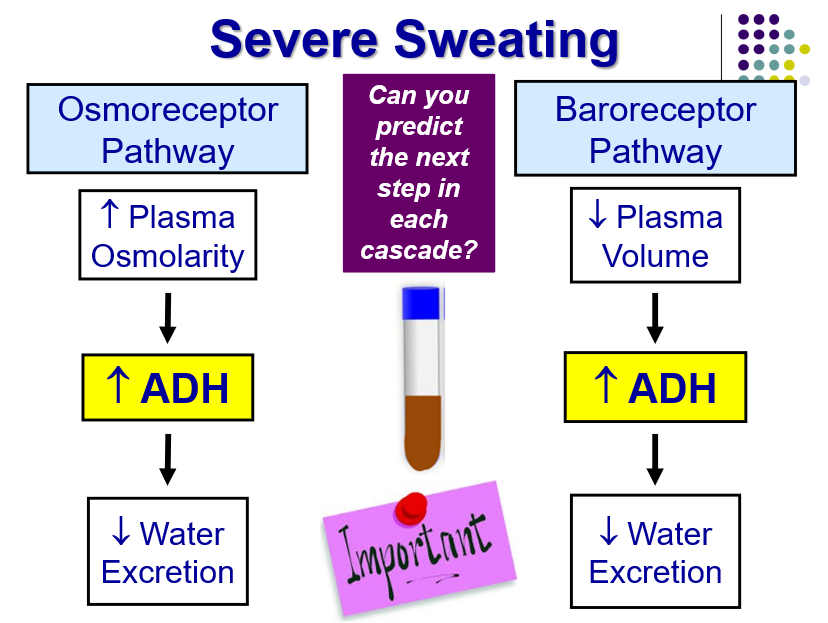L41 | Renal Water Balance
1/31
There's no tags or description
Looks like no tags are added yet.
Name | Mastery | Learn | Test | Matching | Spaced |
|---|
No study sessions yet.
32 Terms
Describe the mechanism of action of vasopressin and where it acts
Vasopressin increases water reabsorption in the kidney by making the collecting duct more permeable to water.
Vasopressin (ADH) acts on V2 receptors in the collecting duct to insert aquaporin-2 channels
Explain how the properties (physical juxtaposition, placement in the renal medulla, and transport characteristics) of the ascending and descending limbs of the loops of Henle allow them to contribute to producing a concentrated urine
The loop of Henle can concentrate urine because:
limbs sit right next to each other and flow opposite directions (countercurrent)
This layout allows each limb to influence the other, multiplying small differences in osmolarity into a large osmotic gradient—the countercurrent multiplier.
They run deep into the high-osmolarity medulla
Because the loop is physically located in this gradient, it can:
(1) Pull water out of the descending limb (where water can move)
(2) Pump salt out of the ascending limb (where salt can move)
The descending limb loses water, and the ascending limb pumps out salt
Ascending limb pumps salt out → makes medulla hyperosmotic
Descending limb loses water → fluid becomes concentrated
Together, these characteristics generate the medullary osmotic gradient needed to produce concentrated urine.
_______________ → urine flow above usual levels
_______________ → urine flow below usual levels (hyperosmotic urine)
diuresis → urine flow above usual levels
antidiuresis → urine flow below usual levels (hyperosmotic urine)
_________ → detect plasma osmorality
Osmoreceptors → detect plasma osmorality
When osmolarity increases, ADH ______________ to conserve water.
When osmolarity increases, ADH secretion increases to conserve water.
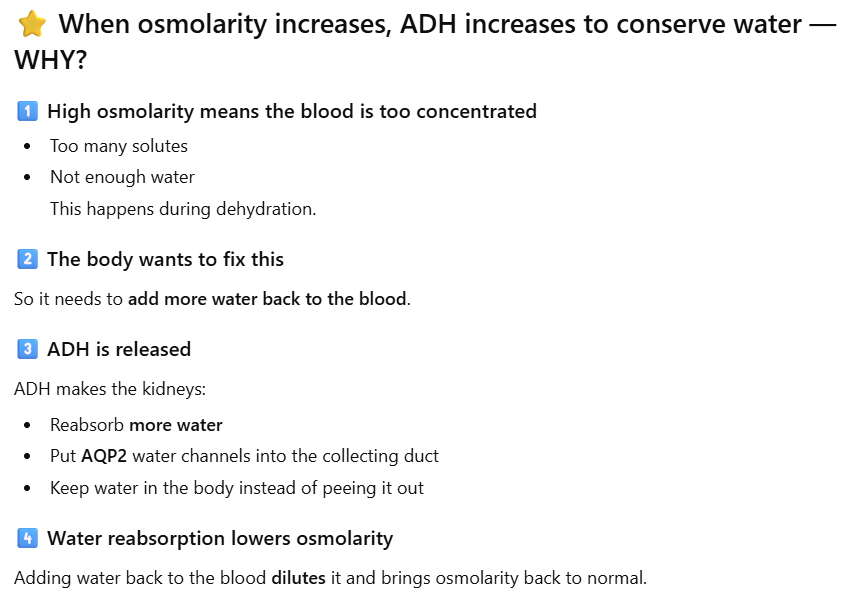
Low arterial pressure → _________ baroreceptor firing → __________ ADH secretion
Low arterial pressure → decrease baroreceptor firing → increase ADH secretion (more water reabsorption)
Sweat is a _______________ solution, meaning it has ______ water than solutes
Sweat is a hypoosmotic solution, meaning it has more water than solutes
Sweating removes dilute fluid (hypoosmotic), causing ECFV to ____________ and the osmolarity of body fluids ___________
Sweating removes dilute fluid (hypoosmotic), causing ECFV to decrease and the osmolarity of body fluids increase
What are the mechanisms by which the kidneys respond to sweating to decrease excretion of both salt and water
After sweating, the kidneys conserve water via ADH and conserve salt via RAAS (renin → angiotensin II → aldosterone), while reducing GFR to minimize both water and Na⁺ loss.
Compare the stimuli for thirst with the stimuli for vasopressin secretion
Both thirst and ADH (vasopressin) are triggered by ↑ osmolarity and ↓ blood volume
An _________ in angiotensin II can stimulate thirst
An increase in angiotensin II can stimulate thirst
The body regulates the loss of water mainly through __________
The body regulates the loss of water mainly through urine
Because output of water is greater than input during prolonged heavy exercise, your body increases its ___________ to consume more water
Because output of water is greater than input during prolonged heavy exercise, your body increases its thirst to consume more water
T/F: Kidney’s control of H2O excretion is dependant on Na+, K+, urea
False; Kidney’s control H2O excretion independently of Na+, K+, urea
____________ is always open and present in the membranes for H2O to be permeable for nephrons
AQP1 is always open and present in the membranes for H2O to be permeable for nephrons
Where is water permeable when ADH is low?
proximal tubule
thin descending limb of Henle
Where is water permeable when ADH is high?
proximal tubule
thin descending limb of Henle
collecting duct
Hypoosmotic urine → more _______________
Hyperosmotic urine → more _______________
Hypoosmotic urine → more diluted
Hyperosmotic urine → more concentrated
What are the requirements for production of concentrated urine? Why does it work?
(1) Hyperosmotic medullary interstitium
Serves as osmotic equilibrating device
(2) antidiuretic hormone (ADH =AVP)
ADH dependent water channels, AQP2
Passive reabsorption of water by osmosis
Why it works?
descending loop of Henle is not permeable to solutes, but permeable to H2O
ascending loop of Henle is not permeable to H2O, but permeable to solutes
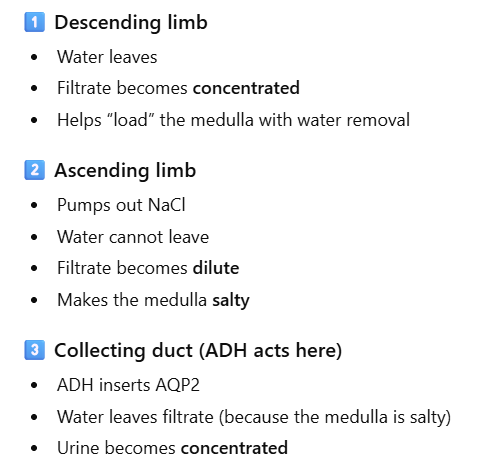
What causes concentrated urine?
High ADH → AQP2 insertion → collecting duct becomes water-permeable → water leaves tubule via osmosis into salty medulla → concentrated urine.
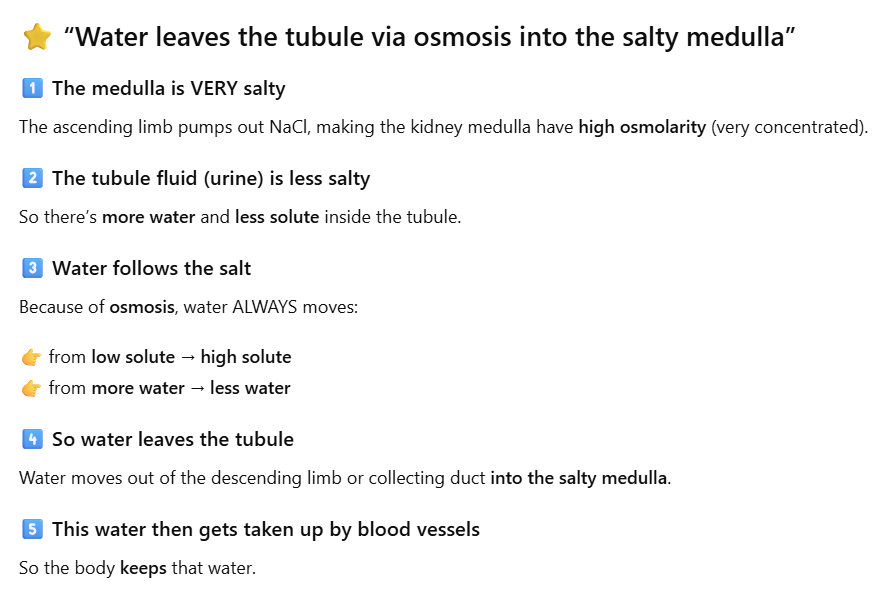
How does urine become diluted?
Urine becomes dilute as it moves through ascending limb of loop of Henle due to Na+ reabsorption & H2O impermeability
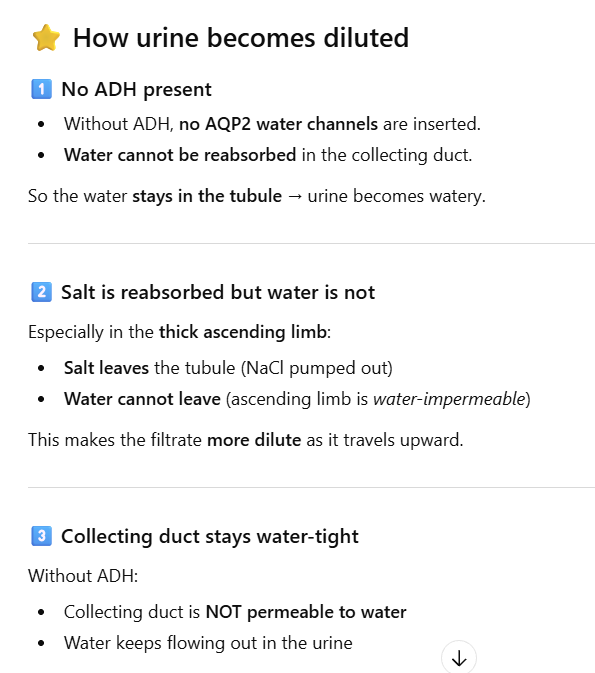
What are the stimuli for ADH release?
osmoreceptors
baroreceptos
What makes the collecting duct water-permeable?
ADH makes the collecting duct water-permeable by inserting AQP2 channels into the luminal membrane so water can leave the tubular fluid and be reabsorbed.
ADH travels in the blood and binds to V₂ receptors on the basolateral membrane of collecting duct cells (side facing interstitial fluid/blood).
Binding of ADH activates Adenylate Cyclase, converting ATP → cAMP, which activates Protein Kinase A (PKA).
PKA causes phosphorylation of proteins → vesicles containing AQP2 channels move and fuse with the apical (luminal) membrane. AQP2 is the only regulated aquaporin.
Now that AQP2 is inserted, water moves down its osmotic gradient from the urine in the lumen → into the collecting duct cell.
On the basolateral membrane, AQP3 and AQP4 are always present and open (not regulated by ADH). Water exits the cell through these channels into the interstitial fluid → blood.
AQP2 is regulated by ______________
AQP2 is regulated by ADH
With ADH → AQP2 inserted → water reabsorbed → ____________ urine
With ADH → AQP2 inserted → water reabsorbed → concentrated urine
What is the flow of water through the collecting duct to be reabsorbed back into the blood?
Tubular lumen → AQP2 → inside cell → AQP3/4 → interstitial fluid/blood
_________ and ___________ are always present, located on the basolateral membrane, but are not regulated by ADH
AQP3 and AQP4 are always present, located on the basolateral membrane, but are not regulated by ADH
What are the tubular actions of ADH?
o (1) AVP/ADH binds V2 receptor
basolateral membrane
o (2) Insert Aquaporin 2 – (AQP2)
luminal membrane
___________ and/or _____________ require antidiuresis
Water restriction and/or severe sweating require antidiuresis
____________ requires diuresis
high water intake requires diuresis
_____________ are the most important stimulus for thirst under most physiological conditions
Osmoreceptors are the most important stimulus for thirst under most physiological conditions
Why severe sweating triggers ADH release through two different pathways? (How does your body defend against dehydration?)
Osmoreceptor Pathway
increase plasma osmolarity
increase ADH
decrease water excretion
Baroreceptor Pathway
decrease plasma volume
increase ADH
decrease water excretion
